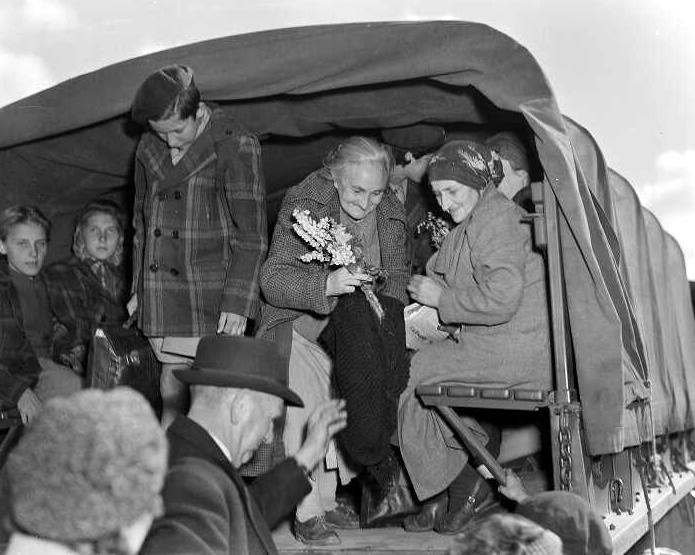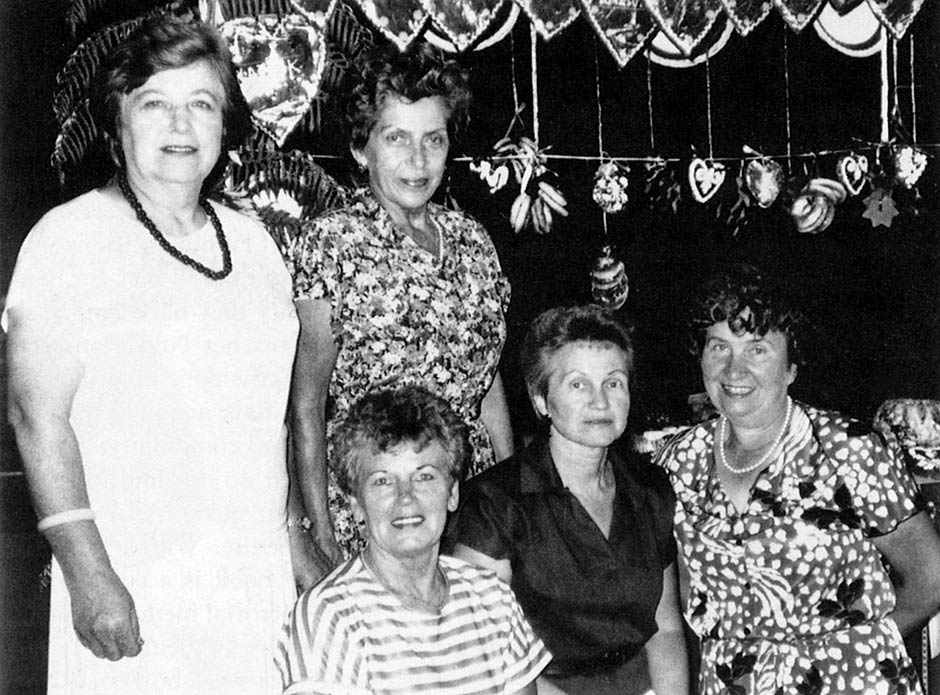This essay written by Theresa Sawicka was first published in Women Together: a History of Women's Organisations in New Zealand in 1993. It was updated by Zofia Atkin in 2018.
1965 – 1993
Koło Polek, or the Polish Women's League, began as an association of Polish émigré women, affiliated to similar organisations in other countries. As part of the Polish community which gathered under the auspices of the Polish Association in Wellington, it catered for the special needs of Polish women (and their adult daughters) who came to New Zealand in the post-war period.
The women were uprooted from their homes largely as a result of World War II and its political aftermath, and came to New Zealand in several distinct waves of migration. The 'Pahiatua Poles', most of them children, came in 1944, followed by Polish ex-servicemen and their kin in 1947, and the 'displaced persons' in 1949–51. The league's membership was drawn mainly from these three groups, but its origins lay in the needs and aspirations of the Pahiatua children.

Alexander Turnbull Library, 1/2-003653-F.
Polish refugees enroute to camp at Pahiatua. This group of girls and women was photographed by John Dobree Pascoe on 1 November 1944.
In 1948, Poles in Wellington formed the Polish Association, which became an umbrella organisation for smaller Polish interest groups. [1] Women participated in these groups, whose activities centred on two all-important goals: opposition to the regime in Poland, and maintenance of Polish language and culture.
In 1965 the Polish Association bought a run-down bakery in Newtown for a new Polish House, and renovated it through voluntary labour – the men doing the building and the women providing domestic support. The project brought Poles together, transforming their club into a community and creating a new focus for Polish social life. By then the hardships of their uprooting – learning a new language, finding work, establishing new homes, starting families and founding a viable ethnic association – were fading as they established new lives. The women now had the time to turn to their own needs.
The Polish Women's League was inaugurated in July 1965, with Teresa Ciesielska as the first president. Membership soon swelled from twenty to 72, and in 1992 stood at 66. The constitution allowed all women of Polish descent and those related to persons of Polish descent to become members. The league's founders sought to enhance their community life; to form a bridge between the world their children were growing up in and the one they had left behind; and to nurture Polish customs and traditions, acting in their own traditional role of gospodyni –homemaker, cook, preserver of customs, and hostess to guests. [2] Many of the league's activities still revolved around this role in the early 1990s.
Members recalled that their personal reasons for forming the league were to help and support one another, and that mutual support remained, for many, the league's biggest achievement. Post-war Polish migrants were mainly single people and families who had lost their kin during the war. By the 1960s, the young women from the Polish Children's Camp in Pahiatua were wives with young families. Many had spent their formative years in camps and had little personal experience of parenting skills. For them the league was a meeting place where they could share the difficulties of marriage and motherhood in an alien culture, pool their knowledge, and acquire new skills. League members became sisters and mothers to one another in the absence of real kin.
In the early years the league's monthly meetings featured talks and demonstrations on topics such as housekeeping, child-rearing, cooking and health; afterward the committee provided a special supper and there was time to relax and talk. Members played games and ran raffles, and celebrated their jubilees, feast days and departures for overseas trips with Polish customs of gift-giving. Although meetings still followed a similar pattern in the 1990s, formal talks were less frequent, the ageing membership preferring a more social programme.
Customs belonging to the agrarian world of pre-war Poland were co-opted in the post-war Polish diaspora as markers of identity and a focus for community life. The league turned some of these customs into social activities, held in Polish House. Two of the most important were Andrzejki and Kaziuk, merry-making festivals similar to Mardi Gras, taking place before Advent and Lent. The league celebrated Andrzejki with an evening of music, gypsy fortune-telling and a Polish supper. Kaziuk was celebrated with a magnificent Polish lunch featuring special regional dishes from eastern Poland. League members decorated traditional honey cakes (rather like gingerbread), which they sold as part of their fundraising. The organisation of such large gatherings involved an army of helpers for days beforehand. The women decorated the hall, cooked and served the food, acted as hostesses, and might also perform a revue which they had written themselves.

Members of Koło Polek celebrating Kazuik with a display of traditional honey cakes (pierniki), 1989.
These women came to New Zealand with nothing, and for many years the organisation had no resources but the skills and physical labour of the women themselves. League members used these resources to raise money for many causes, not necessarily all Polish. In their own community they funded the facilities in Polish House, the Saturday School (teaching Polish language, history and folk customs to the children of immigrants), the dancing group, and the Polish priests. Through their efforts, league members acquired the skills and the confidence to participate in the wider New Zealand community.
Used to working tirelessly for others, league women did not find it easy to focus their efforts on themselves. The publication of their memoirs, A Bouquet of Thoughts and Reminiscences (1991), marked a departure. With a prologue entitled, 'By ourselves, of ourselves, for ourselves', the book was a collection of poems, stories, prayers, memoirs, photographs, Polish pictorial memorabilia and appendices of the league's accomplishments, contributed by 47 members.
The spirit of the league and its sense of togetherness were born of a common experience of war and exile and a shared love of Polish custom and traditions. The name, Koło Polek, which translated literally means 'circle of Polish women', described the dominant ethos of the league, as a place where Polish women stood side by side to create a sense of community.
Theresa Sawicka
1994 – 2018
The league had begun as a group of young and middle-aged Polish women, native Polish speakers with a common interest in Polish culture and traditions. With the passage of time, their daughters and the younger generation of Polish women were less interested in joining; the original members aged and, inevitably, some died. It became very difficult to find volunteers to serve on the committee and to continue organising dinners and festivals for the Polish community.
During this later period the league had to be suspended twice for a year, because it proved impossible to elect a committee. But the need to continue to meet and socialise, especially as many women were widowed, always prevailed and the league survived till April 2018. There was still some fundraising, but with less effort than before. The focus was put rather on visiting and supporting sick members and on social activities.
Meetings started to be held bi-monthly, with talks about famous Polish people, poetry readings, screening videos, or meeting visitors. Outings were organised for members and their spouses two or three times a year. In December there was a festive afternoon tea for all Polish seniors, with carol singing and sometimes Christmas productions. From 2010, the younger generation of women of Polish descent began organising this event.
Modest income and interest on a bank deposit allowed the league to continue as before with its main objective of supporting various charitable causes in New Zealand and abroad. But the burden of keeping accounts and secretarial work become too much for the few people who performed those functions repeatedly. Therefore, in April 2018 the Polish Women's League was dissolved. The former members continued to meet bi-monthly, as before, in the Polish House in Newtown, Wellington.
Zofia Atkin
Notes
[1] In 1993, Wellington had the largest concentration of Poles in New Zealand.
[2] This is not the same as the role of homemaker in contemporary New Zealand. A title of address from peasant Poland, it denotes land-owning, and domestic and cultural management.
Unpublished sources
Polish Women's League records, 1965–1992, Polish Women's League, Wellington
Sawicka-Brockie, Theresa, 'Forsaken Journeys: The "Polish" Experience and Identity of the "Pahiatua Children" in New Zealand', PhD Thesis, University of Auckland, 1986
Published sources
Benet, Sula, Songs, Dances and Customs of Peasant Poland, Dennis Dobson, London, 1951
Petone Settlers Museum, Living in Two Worlds: The Polish Community Wellington, Hutt City Council, Wellington, 1992
Polish Women's League, A Bouquet of Thoughts and Reminiscences, Polish Women's League, Wellington, 1991
Skwarko, Krystyna, The Invited, Millwood Press, Wellington, 1974

Community contributions